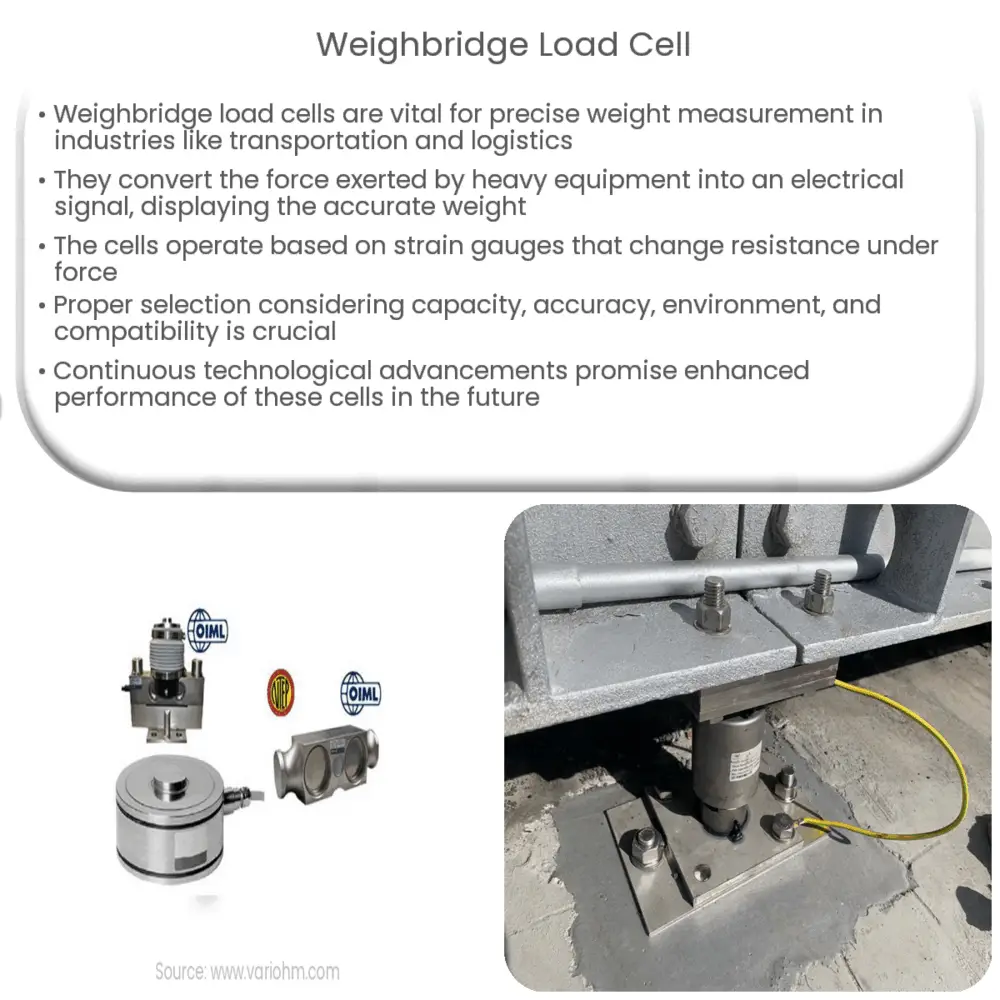Weighbridge load cells are essential devices that convert force from vehicle weight into electrical signals for accurate measurement.

Weighbridge Load Cell: An Essential Component for Accurate Weight Measurement
Introduction
Weighbridge load cells are critical components of weighbridge systems that measure the weight of vehicles, such as trucks, trains, and other heavy equipment. These devices play a vital role in ensuring accurate weight measurement, which is crucial for various industries such as transportation, logistics, and waste management. In this article, we will explore the fundamentals of weighbridge load cells, their working principle, and their importance in maintaining precision and reliability in weight measurement systems.
What is a Weighbridge Load Cell?
A weighbridge load cell is a type of transducer that converts the force exerted by a vehicle’s weight into an electrical signal. This signal can then be processed and displayed as a weight value, allowing for the accurate determination of the vehicle’s load. Load cells are available in various designs and capacities, making them suitable for a wide range of applications, from small-scale operations to large industrial installations.
How Do Weighbridge Load Cells Work?
The primary working principle of a weighbridge load cell is based on the concept of strain gauges. Strain gauges are thin, flexible sensors that can be attached to a load cell’s surface. When a force is applied to the load cell, it causes the strain gauge to deform. This deformation results in a change in the gauge’s electrical resistance, which is directly proportional to the applied force. The change in resistance is then measured and converted into an electrical signal that can be used to determine the weight of the load.
Weighbridge load cells are typically made of high-quality stainless steel or alloy steel to ensure durability and accuracy. They are designed to withstand harsh environments and provide consistent performance over a long period. To ensure the highest level of accuracy, weighbridge load cells are often hermetically sealed to protect against moisture, dust, and other contaminants that could affect their performance.
Importance of Accurate Weight Measurement
Accurate weight measurement is essential for several reasons, and weighbridge load cells play a crucial role in ensuring this accuracy. Some of the key benefits of precise weight measurement include:
- Regulatory Compliance: Many industries are subject to strict regulations regarding the transportation of goods, such as weight limits and safety requirements. Accurate weight measurement helps companies comply with these regulations and avoid penalties or fines.
- Optimizing Load Capacity: By accurately measuring the weight of a vehicle, companies can optimize their load capacity, ensuring that they are not overloading or underloading their vehicles. This can lead to significant cost savings and improved efficiency.
- Safety: Overloading vehicles can cause accidents or damage to infrastructure, such as bridges and roads. Accurate weight measurement helps prevent these issues and ensures the safety of drivers and the public.
Types of Weighbridge Load Cells
Weighbridge load cells come in various types and designs to cater to different applications and requirements. Some of the most common types include:
- Compression Load Cells: These load cells are designed to measure compressive forces and are commonly used in weighbridge systems. They provide high accuracy and can handle heavy loads, making them suitable for large vehicles and industrial applications.
- Tension Load Cells: Tension load cells measure tensile forces and are often used in applications where a force is applied in a pulling motion. Although less common in weighbridge systems, they can be found in some specialized applications.
- Shear Beam Load Cells: Shear beam load cells are designed to measure forces applied in a shearing motion. They are versatile and can be used in both compression and tension applications, making them suitable for a wide range of industries.
Key Considerations for Selecting Weighbridge Load Cells
When choosing a weighbridge load cell for a specific application, several factors need to be considered to ensure optimal performance and reliability. Some of these factors include:
- Capacity: The load cell’s capacity should match the maximum weight that the weighbridge system is expected to handle. Overloading a load cell can cause damage and affect the accuracy of the system.
- Accuracy: Load cell accuracy is vital for ensuring precise weight measurement. It is essential to select a load cell with an appropriate accuracy level for the intended application, considering factors such as temperature, humidity, and load distribution.
- Environment: Weighbridge load cells must be able to withstand harsh environmental conditions, such as dust, moisture, and temperature fluctuations. Ensure that the selected load cell is suitable for the specific environment where it will be installed.
- Compatibility: The load cell should be compatible with the weighbridge system’s existing components, such as mounting hardware, junction boxes, and display units. Compatibility is crucial for ensuring smooth integration and reliable performance.
Conclusion
Weighbridge load cells are essential components of weight measurement systems that play a vital role in ensuring accuracy, efficiency, and safety across various industries. By understanding the working principle, types, and key considerations for selecting the right load cell, businesses can optimize their weighbridge systems and reap the benefits of accurate weight measurement. With the continuous advancements in technology, the future of weighbridge load cells promises even greater accuracy, durability, and versatility, further enhancing their importance in weight measurement applications.

